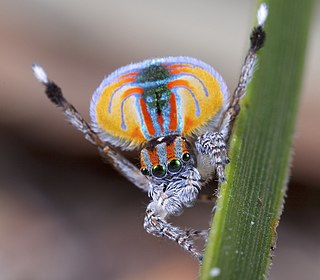
Myrmarachne is a genus of ant-mimicking jumping spiders that was first described by W. S. MacLeay in 1839. They are commonly called ant-mimicking spiders, but they are not the only spiders that have this attribute. The name is a combination of Ancient Greek μύρμηξ, meaning "ant", and ἀράχνη, meaning "spider".

Ascyltus are a genus of jumping spiders in the family Salticidae that was first described by Ferdinand Anton Franz Karsch in 1878. As of December 2020, the genus contained 10 species. Ascyltus spiders utilize their vision in courtship, hunting, and navigation. They are typically large to medium-sized salticids and often move relatively slowly. However, they are capable of agile jumps when moving, hunting, or to avoid predators. They have well developed book lungs and tracheal systems, and they are capable of utilizing both systems. Ascyltus have four pairs of eyes, with the anterior median pair being the most prominent. One distinguishable characteristic of the genus is their antero-lateral carapace, which is iridescently coloured.

Cocalus is a genus of jumping spiders that was first described by Carl Ludwig Koch in 1846, and is named after Cocalus, a Sicilian king of Greek mythology.

Cosmophasis is a genus of spiders in the family Salticidae. They are predominantly Southeast Asian, while some species occur in Africa and Australia. Although most species more or less mimic ants, there are also colorful species that follow a different strategy.
Ergane is a genus of jumping spiders that was first described by Ludwig Carl Christian Koch in 1881. Males of E. benjarei is 9 millimetres (0.35 in) long. The form of the pedipalp and the abdominal pattern suggest that Ergane is close to Chalcotropis. It is named after the goddess Athena, called Athena Ergane as the patron of craftsmen and artisans.

Maratus is a spider genus of the family Salticidae. These spiders are commonly referred to as peacock spiders due to the males' colorful and usually iridescent patterns on the upper surface of the abdomen often enhanced with lateral flaps or bristles, which they display during courtship. Females lack these bright colors, being cryptic in appearance. In at least one species, Maratus vespertilio, the expansion of the flaps also occurs during ritualised contests between males. The male display and courtship dance are complex, involving visual and vibratory signals.

Opisthoncus is a genus of South Pacific jumping spiders that was first described by Ludwig Carl Christian Koch in 1880. There are still many Australian species that have not yet been described.
Pristobaeus is a genus of jumping spiders that was first described by Eugène Louis Simon in 1902.

Salticus is a genus of the family Salticidae. Salticus is the type genus for the family Salticidae.

Thyene is a genus of jumping spiders that was first described by Eugène Louis Simon in 1885. It is a junior synonym of Mithion, and senior synonym of Brancus, Paramodunda and Gangus.
Viroqua ultima is a species of spider in the family Salticidae. It is the only described species of the genus Viroqua. It is only found in Australia. The species was first described by Ludwig Carl Christian Koch in 1881, in the genus Jotus, and was transferred to the new genus Viroqua by George and Elizabeth Peckham in 1901. It is likely that the Peckhams derived the genus name from Viroqua, Wisconsin, as they named genera after unrelated locations on several other occasions.

Zenodorus is a genus of the jumping spiders distributed from the Moluccas to Australia, including several islands of the Pacific. It was once considered a junior synonym of Omoedus, but this was later rejected by Jerzy Prószyński in 2017. At least one species, Z. orbiculatus, specializes on hunting ants.
Astia is a monotypic genus of Australian jumping spiders containing the single species, Astia hariola. It was first described by Ludwig Carl Christian Koch in 1879, and is only found in New South Wales and Queensland. They are noticeable by the patterns on the dorsal surface of the abdomen that are either a creamy white or orange pale patch.

Euophryini is a tribe of jumping spiders. It has also been treated as the subfamily Euophryinae.
Storena is a genus of ant spiders first described by Charles Athanase Walckenaer in 1805.
Pungalina is a genus of Australian jumping spiders that was first described by Barry J. Richardson in 2013.

Jotus karllagerfeldi is a species of jumping spider of the genus Jotus described in 2019. The name of the species karllagerfeldi was chosen as the black and white spider was "reminiscent of the signature look" of fashion designer Karl Lagerfeld. The spider was found near Lake Broadwater, a lake near Dalby, Queensland.

Maratus pavonis is a species of jumping spider (Salticidae), endemic to Australia, where it is found in Western Australia, New South Wales, Victoria and Tasmania. The species epithet, pavonis, derives from the Latin, pavo, pavonis, meaning "peacock".
Jotus remus is a species of spider in the family Salticidae, found in Australia. It was first described in 2016. Males of Jotus remus are distinguished from other species in the genus Jotus by the presence of "paddles" formed by long bristles (setae) on the metatarsus and tarsus of the third pair of legs. The paddles are flattened parallel to the male's body. They are used to attract females by waving them over the edge of a leaf while the male is on the opposite side to the female. The female initially attempts to attack the paddle, but males are skillful at avoiding such attacks. Eventually the female ceases to attack, and the male is able to move to the female's side of the leaf and mate rapidly. Females are difficult to distinguish from those of other Jotus species.












